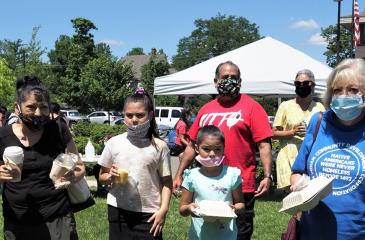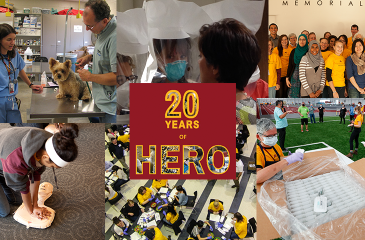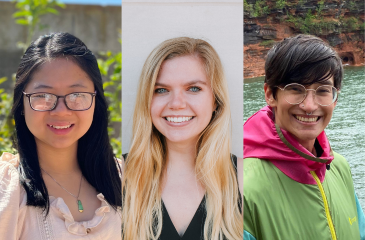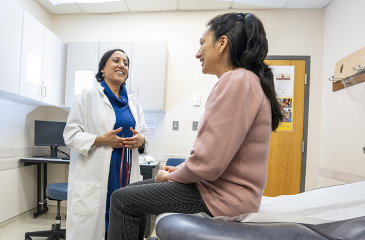In June, during the civil uprising following the murder of George Floyd, members of the American Indian Movement (AIM) watched over the Philips and Seward neighborhoods and protected neighborhood centers, including the University’s own Community-University Health Care Center (CUHCC) and the Native American Community Clinic (NACC). AIM and CUHCC were both formed in south Minneapolis during the late 1960s as a response to systemic issues of poverty and police brutality against residents of the Phillips neighborhood, including Native Americans. AIM continues to battle these issues today.
“When the riots started, we activated AIM to patrol in South Minneapolis and protected 15 Native organizations throughout the city, many along Franklin Avenue. We’ve been out numerous times since then and will continue to be out there protecting our community,” said Frank Paro, president of AIM.
During the civil unrest in June, AIM formed an overnight watch for several nights, along the cultural corridor on Franklin Avenue. They helped to board up businesses and made sure no harm came to their community and the important agencies that serve their neighbors.
“There’s a story I heard once about how a herd of buffalo behaves when confronted by a storm. They turn together and head into the storm and run toward it, the strongest on the outskirts, the young and old at the center. I am reminded of this now seeing our community protectors,” said NACC CEO Antony Stately, who is an enrolled member of the Oneida Nation and a descendent of the White Earth and Red Lake Nations.
Both NACC and CUHCC clinics were guarded by AIM over several early June days and nights. Stately, CUHCC CEO Colleen McDonald Diouf, and NACC Executive Assistant Ashlee Jallen discussed what they could do to show their appreciation. They had the idea to feed AIM members and brainstormed how they could make this happen with COVID considerations. Community clinics and agencies, CUHCC, NACC and Native American Community Development Institute (NACDI) came together to offer their support.
“We have always been incredibly honored to be part of this vibrant community and for the close partnership we share with NACC, NACDI and so many other community-led agencies. It becomes essential, now more than ever, to be able to rely on our neighbors during these challenging times. We deeply appreciated the opportunity to thank the AIM Protectors,” said McDonald Diouf from CUHCC.
On Friday, July 10, NACC, CUHCC, and NACDI hosted a gratitude lunch for AIM members. The luncheon took place outside of the American Indian Community Development Center on Franklin Avenue in South Minneapolis. A mural was unveiled during the event in honor of AIM and their work. Representative Ilhan Omar attended as well.
“The mural is a painting of the southside cityscape. It blends traditional designs from the Dakota and Anishinaabe whose lands this city is built upon. I hope this space invites people to come together to share thoughts on decolonization, community collaboration, and self-determination,” said Rory Wakemup, a local artist who helped collaborate on the mural along with Courtney Cochran and Natchez Beaulieu.
“The luncheon really showed how a community can come together in difficult times. This was a collective movement, a beautiful display of everyone coming together to honor protectors,” said Stately. “My brother served barbeque, my nephew performed a traditional drum circle and sang an honor song and translated for non-natives. Positive stories like this aren’t often highlighted.”
One of NACC’s values is to be a good relative to all. They are dedicated to decreasing health disparities for Native American families in the Twin Cities and take a wide-view approach to health care by addressing access to food, housing and health insurance. They have had a longstanding partnership with CUHCC, who was the first health center in the neighborhood to provide care to Native Americans in the 1970s. Today, CUHCC partners with NACC and other clinics on key services that support health and wellbeing.
“The day of the event was a huge success, and we are grateful for everyone that came out,” said Jallen. “The community came together to share a meal and give thanks.”
Stately adds, “I grew up in South Minneapolis in the ‘60s and ‘70s. I’ve seen many movements. This moment feels different. Today’s youth and the energy they bring gives me hope for the future. 2020 is a year of change.”
McDonald Diouf concurs, “While we need to keep shining a light on the struggles and challenges to inspire and activate change, we need to ground ourselves in the stories that celebrate the everyday examples of how community comes together. Our youth are leading this work and are our legacy.”



